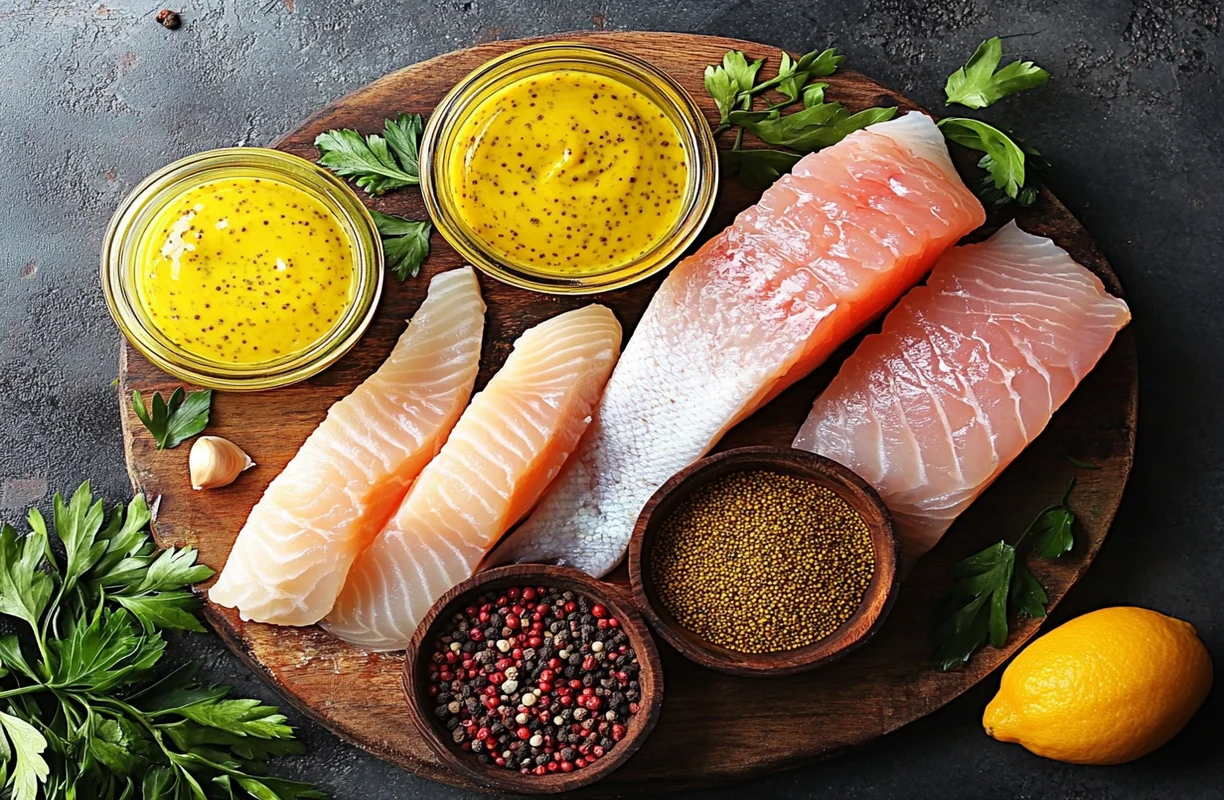Introduction
In the culinary world, chefs and home cooks alike are always on the hunt for techniques to elevate simple recipes. One such hack is applying mustard to fish before frying. It’s a practice that has been embraced for generations, particularly in Southern and Creole cuisine, where bold flavors reign supreme. But why is this technique so popular? What does mustard do to fish, and how can you use it to enhance your next seafood meal? This article delves into the science, benefits, and techniques of using mustard on fish, proving why it’s a must-try for anyone who loves fried fish.
The Science Behind Mustard in Cooking
Cooking is as much a science as it is an art, and mustard plays a fascinating role in transforming the flavors and textures of fish. By understanding how mustard interacts with fish and frying techniques, you can unlock its full potential in your kitchen. Let’s dive into the details.
What Is Mustard, and Why Is It Used?
Mustard is made from ground mustard seeds, water, vinegar, and sometimes additional spices or sweeteners. The key ingredient in mustard seeds is sinigrin, a compound that reacts with water to release the sharp, tangy flavors mustard is known for. This natural composition makes mustard a versatile ingredient for marinades, sauces, and seasoning blends.
When it comes to fish, mustard acts as a mild acid, helping to break down proteins in the fish’s surface layer. This tenderizes the fish slightly, creating a soft, flavorful texture while enhancing its natural taste.
How Mustard Enhances Flavor in Fish Frying
Mustard contains compounds that are both aromatic and flavor-enhancing. Its tangy profile cuts through the rich, oily nature of many types of fish, providing balance. It also interacts with seasoning spices, amplifying their taste. In essence, mustard acts as a flavor carrier, ensuring that every bite is packed with complexity.
- Flavor Profile: Mustard has a subtle spice that complements fish without overpowering it.
- Tang and Zest: Its acidity brightens the flavors, making the fish taste fresh even after frying.
- Marinade Magic: The paste-like texture of mustard clings to fish, allowing seasonings and breading to adhere evenly.
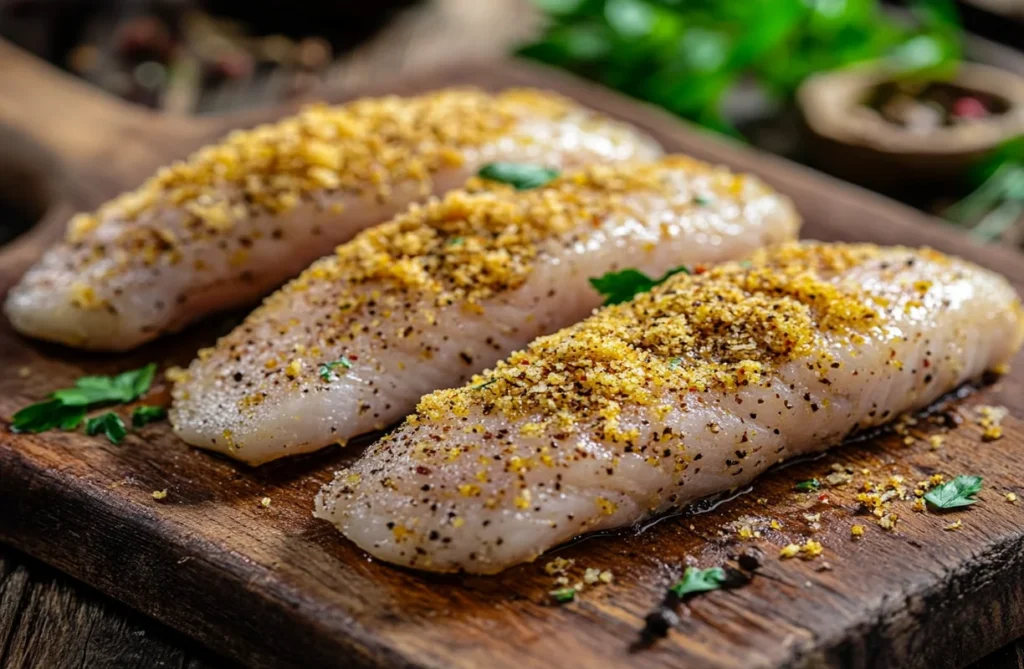
Mustard’s Interaction with Oils When Frying Fish
One little-known fact is how mustard affects frying. When mustard-coated fish is added to hot oil, the mustard forms a light barrier between the fish and the oil. This reduces excessive moisture loss, leading to a crispy crust on the outside while keeping the fish moist on the inside. Additionally, mustard’s spices don’t burn easily, ensuring the breading stays golden rather than charred.
Does Mustard Have Health Benefits?
Aside from its culinary uses, mustard offers potential health benefits. It is naturally low in calories and contains antioxidants, particularly from the mustard seeds and turmeric (if included in the recipe). When paired with fish, a lean protein, the result is a nutritious and delicious dish.
- Rich in Minerals: Mustard contains selenium, magnesium, and phosphorus.
- Anti-Inflammatory Properties: Turmeric in mustard can reduce inflammation.
- Low-Calorie Coating: Compared to heavier coatings like mayonnaise, mustard is a lighter option.
This scientific interplay between mustard and fish is what makes the combination so special. But the benefits don’t stop there. Let’s move on to understanding how mustard impacts the frying process.
The Benefits of Using Mustard on Fish Before Frying
Using mustard on fish before frying offers several advantages that can improve your cooking. It’s a simple technique that brings out the best in the fish’s flavor, texture, and appearance. Let’s explore why mustard has become a favorite in kitchens around the world.
Mustard Acts as a Flavorful Marinade for Fish Frying
Mustard works as a quick and easy marinade. Its tangy and slightly spicy taste blends well with fish, especially mild varieties like cod or tilapia. The acidity in mustard helps to soften the outer layer of the fish, allowing it to absorb seasoning more effectively.
When you coat fish with mustard, you create a foundation for spices to stick. Seasonings like garlic powder, paprika, or cayenne can hold onto the mustard, ensuring the fish is evenly flavored. This extra step adds depth to your dish without requiring extra preparation time.
- Tip: Apply a thin, even layer of mustard to cover the fish completely. This ensures every bite has balanced flavor.
Improves Breading Stickiness
One of the biggest challenges in frying fish is keeping the breading intact. Mustard acts as a natural adhesive, helping breadcrumbs, cornmeal, or flour stick to the fish. This results in a thicker, crispier coating that doesn’t flake off while frying.
Unlike eggs or buttermilk, mustard provides a more even base that grips dry coatings firmly. It also eliminates the need for extra dipping steps, making your prep faster.
- Pro Tip: After coating the fish with mustard, press the breading gently to ensure it sticks well.
Mustard Adds a Tangy Kick to Fish When Frying
The light tang of mustard makes fried fish more exciting. Whether you’re using yellow mustard for its bright taste or Dijon for a richer flavor, it adds a touch of zest that balances the fried crust. This makes the dish feel fresh and flavorful, even when paired with heavier sides like fries or hush puppies.
For those who enjoy bold flavors, mustard can also serve as a base for additional spices. Mix it with hot sauce, lemon juice, or minced herbs to create a signature marinade that reflects your taste.
Creates a Golden, Crispy Crust
Fish coated with mustard fries to a beautiful golden color. The natural sugars in mustard caramelize slightly during frying, adding a subtle sweetness to the crust. This gives your fish an appealing texture that is crispy outside and tender inside.
The mustard layer also seals in moisture, preventing the fish from becoming dry or tough. As a result, every bite is juicy, flavorful, and satisfying.
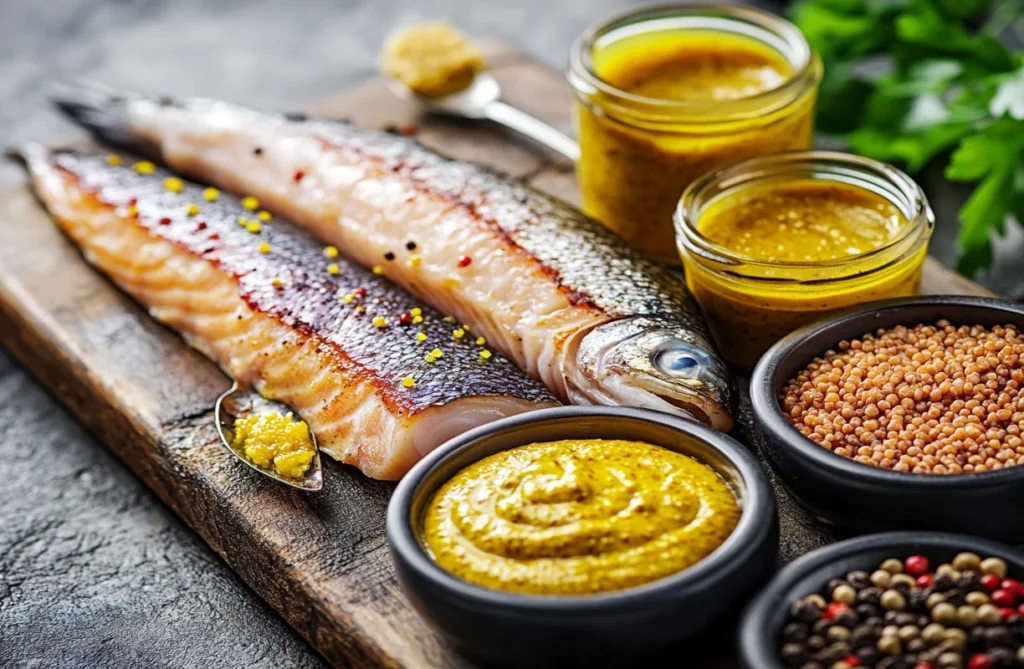
Enhances Both Mild and Bold Fish Varieties
Mustard pairs well with many types of fish. For mild white fish, it adds a pop of flavor without overpowering its delicate taste. For richer options like salmon or mackerel, mustard balances the strong, oily notes, creating a perfect harmony of flavors.
- For Mild Fish: Use yellow mustard for its bright, slightly tangy flavor.
- For Bold Fish: Try Dijon or spicy mustard to match the stronger taste.
The benefits of mustard go beyond just flavor or texture. It simplifies preparation, makes frying easier, and ensures your dish impresses every time.
The Best Types of Mustard for Fish
Choosing the right mustard can make a big difference when frying fish. Each type of mustard has its own unique flavor and texture, which can enhance your dish in different ways. Whether you prefer mild or bold tastes, there is a mustard that fits your style.
Yellow Mustard: A Classic Choice
Yellow mustard is a popular option for frying fish. It has a bright, tangy taste that works well with mild fish like cod or flounder. Its smooth texture spreads easily, ensuring an even coat across the fillet. This type of mustard is ideal if you want to add a subtle tang without overpowering the natural flavor of the fish.
- Best For: Mild white fish like tilapia, catfish, or cod.
- Flavor Tip: Pair yellow mustard with a breading mix that includes cornmeal for a Southern-style dish.
Dijon Mustard: For a Richer Flavor
Dijon mustard offers a slightly spicy and creamy profile. It pairs beautifully with fish that has a stronger taste, such as salmon or trout. Its smoother consistency also makes it easy to combine with spices like garlic powder or paprika for an extra flavor boost.
- Best For: Salmon, trout, or mackerel.
- Flavor Tip: Mix Dijon mustard with a splash of lemon juice for a fresh, zesty marinade.
Spicy Mustard: Adding a Kick
Spicy mustard, often made with brown mustard seeds, gives fish a bold and zippy flavor. It’s perfect for those who enjoy a little heat in their dishes. This type of mustard works best with rich, oily fish, as it cuts through the heavier flavors and adds a lively contrast.
- Best For: Mackerel, tuna, or swordfish.
- Flavor Tip: Combine spicy mustard with crushed red pepper flakes or hot sauce for a fiery finish.
Whole-Grain Mustard: For Texture Lovers
Whole-grain mustard adds a rustic touch to fried fish. The seeds in this mustard provide a slightly crunchy texture, which complements the crispy coating. It’s a great option if you’re looking for a mustard that stands out visually and in taste.
- Best For: Halibut, grouper, or snapper.
- Flavor Tip: Use whole-grain mustard as a base layer, then sprinkle fresh herbs like parsley or dill over the fish before frying.
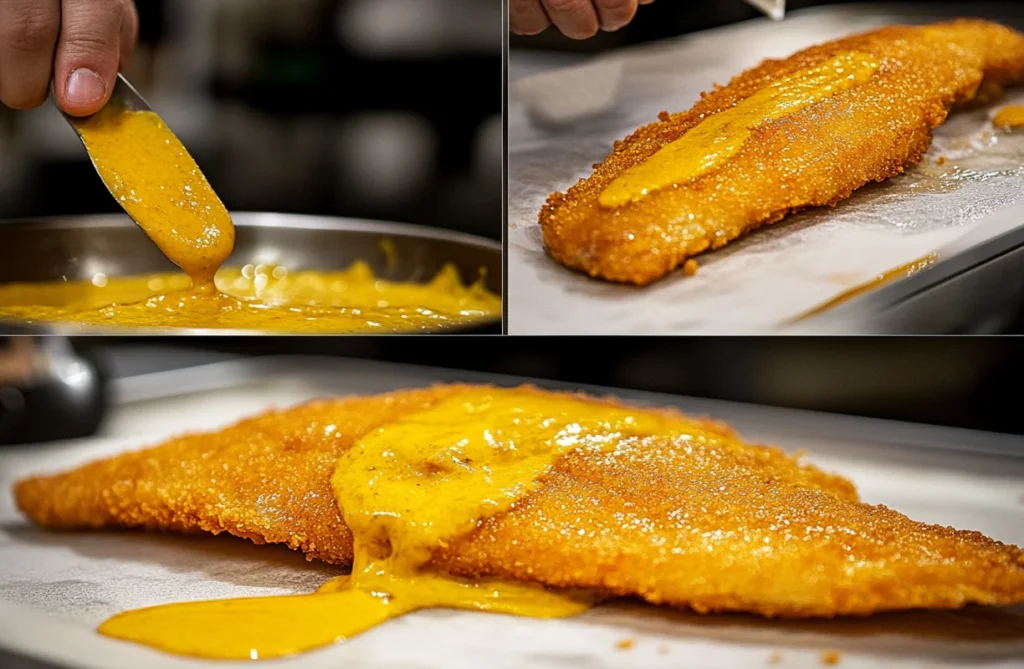
Choosing the Right Mustard for Your Recipe
The best mustard depends on the type of fish you’re frying and the flavor you want to achieve. If you’re unsure, start with yellow mustard—it’s versatile and easy to use. As you get more comfortable, experiment with other varieties to find the one that complements your dish perfectly.
By selecting the right mustard, you’ll not only elevate the taste of your fish but also make the cooking process more enjoyable and creative.
Step-by-Step Guide to Frying Fish with Mustard
Frying fish with mustard is a simple process that doesn’t take much time or effort. This step-by-step guide will help you prepare perfectly crispy, flavorful fish every time.
1. Gather Your Ingredients
Start by collecting everything you’ll need: fresh fish fillets, your choice of mustard, spices, and breading. Having everything ready makes the process smooth and stress-free.
- Ingredients Checklist:
- Fresh fish fillets (tilapia, cod, or salmon work well)
- Mustard (yellow, Dijon, or spicy)
- Seasonings (salt, pepper, paprika, garlic powder)
- Breading (breadcrumbs, cornmeal, or flour)
- Oil for frying (vegetable or canola oil)
2. Prepare the Fish
Before applying mustard, clean and dry the fish. Use a paper towel to gently pat the fillets dry. This helps the mustard stick better and ensures the coating stays crispy during frying.
- Tip: If using frozen fish, let it thaw completely before starting.
3. Coat the Fish with Mustard
Spread a thin, even layer of mustard over each fillet. You can use a brush, the back of a spoon, or your fingers. Make sure to cover both sides so the breading adheres well.
- Tip: Don’t apply too much mustard; a thin coat is enough to add flavor and help the breading stick.
4. Add Seasonings and Breading
First, sprinkle your chosen spices directly onto the mustard-coated fish, ensuring even coverage. Next, gently pat the spices onto the surface to help them adhere better. Then, take a moment to check that all sides are evenly seasoned before moving on to the breading step.. Then press the fillet into the breading mix, coating it evenly on all sides.
- For Extra Crunch: Double-dip by applying another thin layer of mustard and breading if desired.
5. Heat the Oil
Pour oil into a frying pan or deep skillet, and then place it on the stove. Next, heat it over medium-high until it reaches about 350°F. To ensure the oil is ready, drop a small piece of breading into the pan. If it sizzles and rises to the surface, you’ll know the oil has reached the perfect temperature for frying.
- Safety Tip: Use enough oil to cover the fish halfway for even cooking.
6. Fry the Fish
Carefully place the coated fish into the hot oil, ensuring you lower it gently to avoid any splashing. As you do this, watch for the oil to sizzle around the edges of the fish, signaling that it’s frying properly. Then, proceed to space out each piece evenly in the pan to allow for even cooking and prevent sticking. Then, fry each side for about 3–4 minutes, or until the crust turns a beautiful golden brown. Meanwhile, be mindful not to overcrowd the pan, as doing so can lower the oil’s temperature and prevent the fish from becoming crispy.
- Tip: Flip the fish gently with a spatula or tongs to avoid breaking the crust.
7. Remove and Drain
Once the fish is cooked, transfer it to a plate lined with paper towels. This step helps absorb any excess oil, keeping the fish light and crispy.
- Serving Idea: Serve the fried fish with lemon wedges, tartar sauce, or a mustard-based dipping sauce for added flavor.
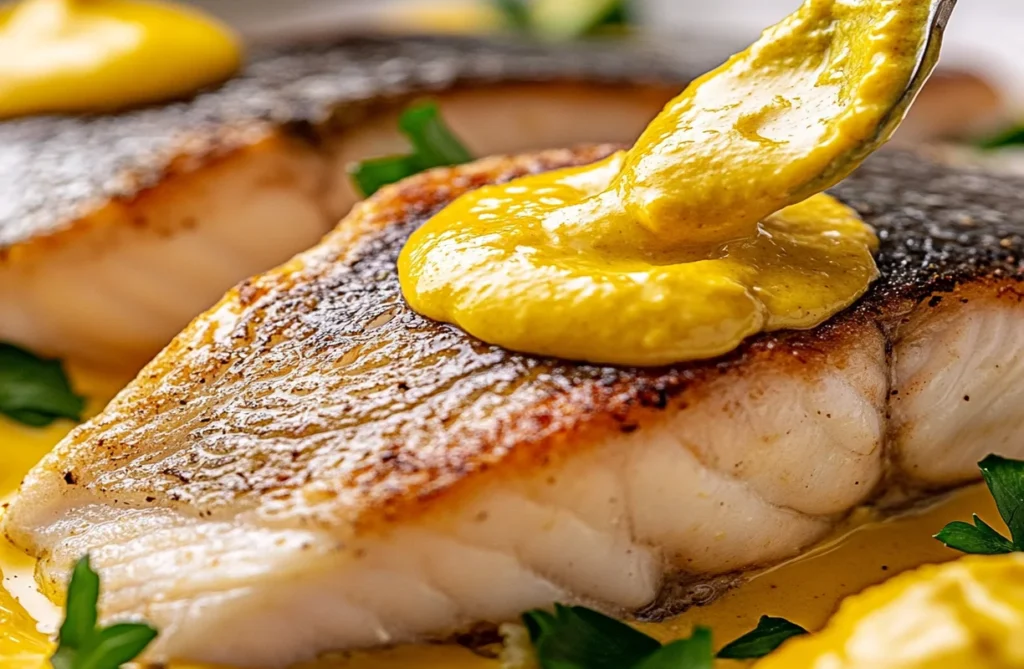
Final Notes on Technique
Frying fish with mustard is as much about enjoying the process as it is about the result. With practice, you’ll find the balance of flavors and textures that work best for you. Whether cooking for family or guests, this method is sure to impress! For more inspiration, check out this Hillbilly Fish Fry Seasoning Recipe.
FAQs
Which Spice Is Good for Frying Fish?
Great spices for frying fish include:
- Paprika: Adds mild smokiness.
- Garlic Powder: Enhances savory flavor.
- Cayenne Pepper: Brings heat.
- Black Pepper: Adds subtle spice.
- Dill or Parsley: Perfect for fresh flavor.
Mix these for a balanced seasoning blend.
What Is the Best Seasoning to Put on Fish?
For most fish, use:
- Salt, Pepper, and Lemon Zest for simplicity.
- Cajun Seasoning for a spicy, smoky kick.
- Old Bay Seasoning for a classic seafood taste.
- Garlic and Herb Mix for subtle flavor.
How to Season Louisiana Fish Fry?
Mix cornmeal and flour, then add:
- Paprika, Garlic Powder, Onion Powder, Cayenne, Thyme, Salt, and Pepper.
For extra zest, add hot sauce to mustard before breading.
Final Thoughts
Adding mustard to fish before frying is a simple step with big rewards. Whether you’re cooking a quick family meal or hosting a dinner, this method brings flavor, texture, and a golden crust that’s hard to beat. For the best results, begin by experimenting with different types of mustard and fish to discover how they complement each other. Along the way, pay attention to how each mustard’s flavor enhances the fish. Additionally, consider trying various cooking techniques, such as frying, baking, or grilling, to explore the full range of possibilities. Finally, take note of your favorite combinations and refine them for future meals. Then, adjust the flavors based on your taste preferences, whether you enjoy something tangy, spicy, or mild. Finally, combine your favorite mustard and fish pairings to create a dish that suits your style perfectly!
Would you like me to summarize everything in a conclusion?

